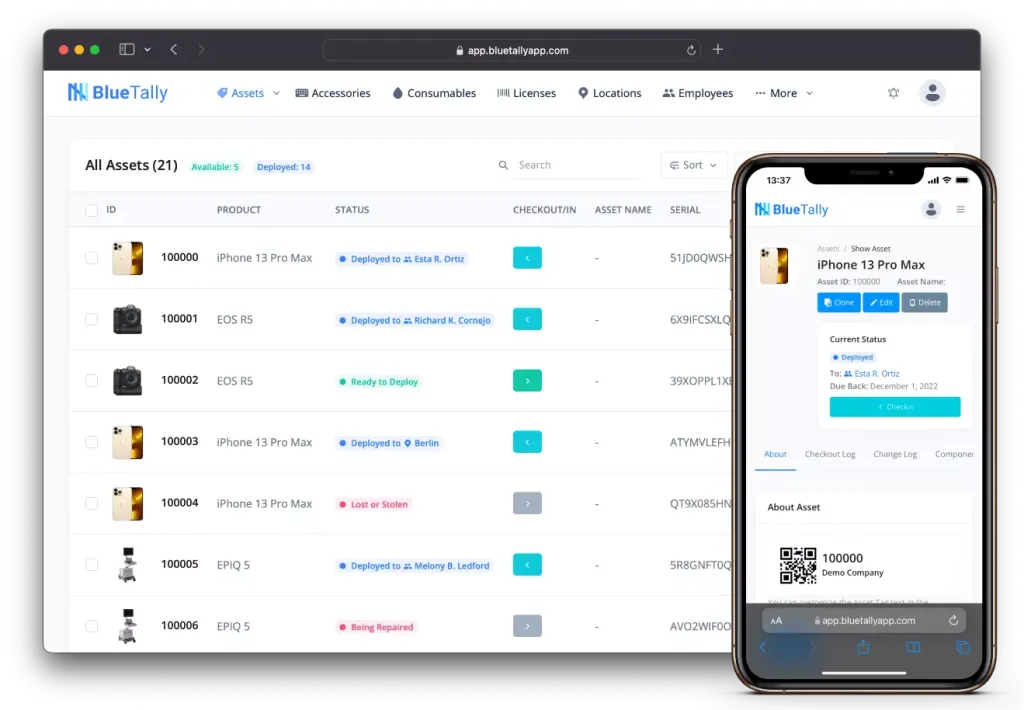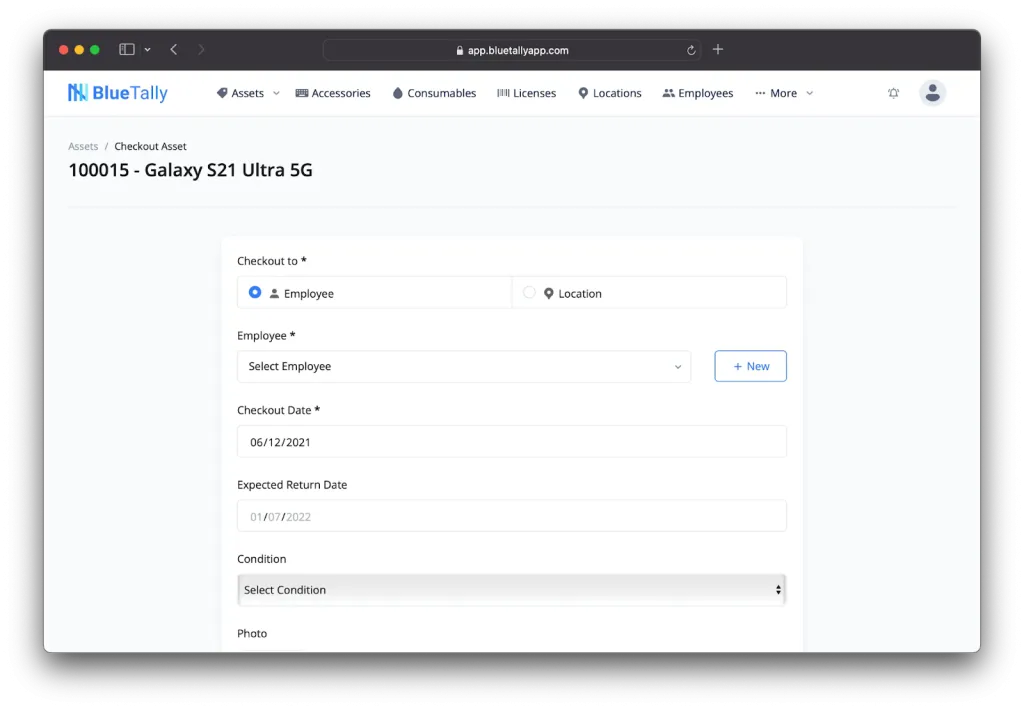We Present Our Guide to Asset Disposal: Management & Best Practices

Helpful Summary
Overview: We explore the best practices in asset disposal management, emphasizing the importance of proper documentation and the use of asset management software, like BlueTally, to automate the disposal process.
Why you can trust us: Our insights are backed by successful case studies and client experiences, demonstrating how BlueTally effectively automates asset disposal, reducing manual effort, and ensuring accurate record-keeping.
Why this is important: Efficient asset disposal is essential for maintaining accurate financial records, freeing up space, and ensuring data security. Automating this process minimizes errors and maximizes resource utilization.
Action points: We recommend using BlueTally to streamline your asset disposal process. We offer valuable features such as asset tagging, automated depreciation calculations, and detailed asset registers to make disposal efficient and compliant.
Further research: Explore the specific features of BlueTally that facilitate asset disposal, such as its integration capabilities and automated reporting. Also, make sure to stay informed about legal and environmental guidelines relevant to asset disposal.
Need Help With Asset Disposal?
As your company expands and grows, you can find yourself accumulating more and more assets — some of which you just don’t need anymore. Assets can become obsolete for a number of reasons, from disrepair to high maintenance costs, so naturally, you’ll want to replace them with something newer.
Before you can do that though, it’s important to properly deal with the old assets through asset disposal. You need proper documentation when it comes to removing unwanted assets, which is made easier by using asset management software like BlueTally.
Before we explain how to conduct your own asset disposal, let’s first dive into what asset disposal actually entails.
Why Listen To Us?
Effective asset disposal management is key to maximizing returns and minimizing risks. At BlueTally, we offer robust features, and comprehensive integrations to help you consolidate asset history, warranty info, and maintenance records, providing a centralized solution for managing asset disposal efficiently and in compliance with best practices.
What is Asset Disposal?
Asset disposal refers to getting rid of a long-term asset from your accounting records by selling, scrapping, or throwing them out altogether. You should manage your assets efficiently during the disposal process to keep your records accurate and avoid any mishaps, such as removing the wrong assets.
It’s important for disposals to be closely monitored since it involves losing or gaining capital. For example, you can keep track of your assets through an asset tagging system, where scannable labels are attached to each one.
Asset disposals should be performed on a yearly basis to ensure your records remain up-to-date. Assets can be removed for a variety of reasons, including maintenance costs, loss of quality or functionality, outdated technology, and so on. BlueTally allows you to view asset statuses, which can help you figure out which assets need disposing:

Every broken piece of equipment should be tagged with a ‘broken’ status — the same goes for those in repair. You can efficiently identify dysfunctional equipment, and view their maintenance logs to get a sense of their upkeep costs. In general, assets that require frequent and costly maintenance should be disposed of.

Why is Asset Disposal Important for Your Business?
Free up Space at Your Office or Facility
Getting rid of old IT assets can free up space for your office and make room for better equipment. Assets that have degraded in quality may also pose a security risk to your data, as they’re no longer in peak condition for protecting against cyber attacks.
Protecting Your Customer Data
Asset disposal must be carefully carried out to avoid any data leaks. You have a responsibility to keep your customers’ data secure, so all assets must be cleared of that data before being disposed of. Creating a detailed asset register can help you keep track of which assets have access to sensitive data.
Maintenance Savings
Removing unused assets saves you a lot of maintenance costs since you’ll no longer have to pay for their upkeep. You can even gain money by selling assets during the disposal process — it’s beneficial to monitor these assets via asset tracking software to ensure they arrive at the right place.
Determining which assets are no longer needed can also help you avoid unnecessary repairs — if an asset is going to be discarded soon, there’s no point in scheduling maintenance for them.
How to Effectively Record Asset Disposal
Now that we’ve gone through the basics, it’s time to discuss how you can record and conduct asset disposal for your business. We’ve broken down the process into several aspects:
Asset Review
First of all, you must conduct an asset review — this is where you make note of all your current assets and assess their condition. Are they in need of repairs or upgrades? Can the asset still do what it needs to do? Reviewing your assets helps you plan for maintenance and monitor an asset’s life expectancy. Consider these questions:
- How long can they last without repair?
- Does it need replacing?
- Is it cost-efficient to continue repairs?
When done properly, asset reviews can minimize equipment failures and loss of inventory. Doing this regularly can also help you identify and fix faults before they do any real damage.
Asset Tracking
Asset tracking is an essential part of asset disposal. Alongside reviewing your assets, you must also find a way to keep track of their location and condition outside of those reviews to ensure they arrive at the right place.
Asset Tags
Most companies make use of asset tags, such as RFID tags (radio frequency identification) and barcodes, which link to online asset management tools like BlueTally. We allow you to generate unique barcodes for each asset, which you can later print as physical labels.
When these labels are scanned, information from your asset register should pop up. Just make sure to attach each label to the correct asset. If necessary, you can update asset information remotely. Asset profiles can include:
- Location
- Status
- Checkout History
- Changelog
- Maintenance Schedule
- Condition
BlueTally is a cloud-based system that specializes in IT asset management — alongside asset tracking, it’s also home to many other useful features, some of which we’ll detail below:
Key Features
Assign Assets & Monitor Checkouts: You can assign assets to a certain location or staff member by checking them out. Add relevant details (e.g., condition, expected check-in date, etc.), along with an image of the asset, upon checkout for easy monitoring.

Checkout History & Detailed Changelog: View an asset’s checkout history and changelog to closely monitor its condition and location. You can even pinpoint causes for damage by reviewing images of the asset between each checkout. The changelog should also show you who updated details about the asset during its lifetime.

Asset Barcodes: Each asset is assigned a unique barcode based on its ID number. These can be printed out as labels and attached to an asset. You can customize the label’s text and set your own ID numbers.

Asset Audit & Maintenances: You can see scheduled asset audits on BlueTally or schedule them yourself. Notifications are sent whenever audits are overdue to ensure you never miss any.

Data Destruction
Data destruction involves deleting data from your online systems or records. Before getting rid of your assets, they must be purged of any important data. Destroying data is an important step in asset disposal, as you can ensure that data is impossible to retrieve from the disposed asset.. It’s irreversible, so ensure you’ve got the right asset before deleting data.
If any data is physical, shredding the information is the quickest and most popular method. Online data, on the other hand, must be wiped.
Valuing Assets
Now it’s time to assess the value of your assets. This is where you decide how to dispose of an asset — do you sell it, or scrap it? In order to determine whether an asset is worth selling (and for what price), you must assess its quality and worth. Consider:
- Looking at the current market value for the same or similar assets
- Look at other second-hand assets (check their condition and pricing)
- Look at the brand’s other products to get a sense of their pricing or worth
You usually only appraise the value of physical assets, such as IT equipment and machinery. Identify what parts of them are damaged and take them into account when deciding on a price. If it’s a really low number, it may not be worth the hassle, meaning it might be best to just scrap the asset in question.
Deploying Assets
Finally, the last step in the disposal process is deployment. Now that you’ve decided how you’ll dispose of your assets (selling, scrapping), it’s time to get rid of them. Delete them from your accounting records, and ship them off to the right location — this can vary depending on whether you’re selling, donating, or recycling them.
Best Practices for Asset Disposal
Collect as Much Information as Possible About the Asset
In order to properly determine which assets need discarding, you should note down as much information as possible about each asset. Gather details from your asset register, audits, and other files. Check your physical documents, digital spreadsheets, or asset management software.
Collecting all this information should help you see whether an asset still serves a purpose or is no longer needed. Make sure to evaluate each asset afterward to ensure the information is accurate and up-to-date.
If you’re struggling to decide on an asset’s worth, try setting some long-term or short-term goals for them to meet. Based on the results, you can determine whether they need maintaining, upgrading, or discarding.
Understand Asset Depreciation
You can enhance your asset disposal by learning about asset depreciation, which refers to how asset value degrades over time and use. This is an important aspect when it comes to evaluating asset quality — ask yourself:
- Which assets can’t be used anymore?
- Why aren’t they suitable for use?
Try to understand the reason behind an asset’s depreciation, such as low functionality or outdated features — this could cause them to hinder work efficiency and create unsatisfactory outputs. Asset depreciation should be regularly monitored so you can quickly locate outdated equipment that’s no longer worth keeping.
BlueTally auto-generates depreciation reports for you to save you the trouble of manually calculating asset value:

Invest in Automated Software
Asset disposal can be a lengthy process, which is why it’s worth investing in automated software, which can speed up certain steps. You can reduce the need for manual labor and automate things like asset tracking, depreciation, and more.
Conclusion
As you garner more and more assets, you’ll find that some of them have become obsolete over time. Keeping hold of unwanted assets do you no favors, so it’s common for them to be removed via asset disposal.
With so much asset tracking and evaluation involved, it’s worthwhile to make use of BlueTally during the disposal. BlueTally is an asset management tool that helps streamline tasks like calculating depreciation and creating asset registers. Check out our free demo today to start automating your asset disposal.






